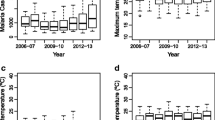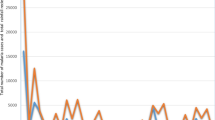Abstract
The connections between malaria incidence and climate variability have been studied in recent time using some mathematical and statistical models. Many of the statistical models in literature focused on time series approach based on Box–Jenkins methodology. However, fitting time series model based on the Box–Jenkins methodology may be challenging. Most malaria incidence data are count and are over-dispersed. In this study, negative binomial models were formulated for fitting malaria incidence in Akure—one of the epidemic cities in Nigeria. In particular, negative binomial models were formulated for each of the number of outpatient individuals, number of inpatient individuals and mortality count as a function of some climate variables. It was found that an increase in minimum temperature and relative humidity at lag 1 significantly increased the chance of malaria transmission and thereby leads to an increase in the number of inpatient and outpatient individuals, as well as the total number of malaria cases. The minimum temperature, rainfall amount and relative humidity of the study area have a significant impact on the increase of number of inpatient and outpatient individuals while mortality count depends on the total number of reported malaria cases. The findings from this study is to offer in-depth understanding on climate-malaria incidence linkages in Akure, Nigeria.
Similar content being viewed by others
References
Abdulkareem, S. B., Adegboyega, S. A., Balogun, I. A., Eteng, W. O., & Adebayo, F. F. (2017). Geospatial analysis of malaria risks in the ancient town of Akure, Ondo State, Nigeria. International Journal of Environment and Bioenergy, 12(1), 88–99.
Abellana, R., Ascaso, C., Aponte, J., Saute, F., Nhalungo, D., Nhacolo, A., et al. (2008). Spatio-seasonal modeling of the incidence rate of malaria in Mozambique. Malaria Journal, 7(1), 228.
Abiodun, G. J. (2016). A mathematical model for studying the impact of climate variability on malaria epidemics in South Africa. Doctoral dissertation, University of the Western Cape, South Africa.
Abiodun, G. J., Maharaj, R., Witbooi, P., & Okosun, K. O. (2016). Modelling the influence of temperature and rainfall on the population dynamics of Anopheles arabiensis. Malaria Journal, 15(1), 1.
Abiodun, G. J., Makinde, O. S., Adeola, A. M., Njabo, K. Y., Witbooi, P. J., Djidjou-Demasse, R., et al. (2019). A dynamical and zero-inflated negative binomial regression modelling of malaria incidence in Limpopo Province, South Africa. International Journal of Environmental Research and Public Health, 16(11), s2000. https://doi.org/10.3390/ijerph16112000.
Abiodun, G. J., Witbooi, P., & Okosun, K. O. (2017a). Modelling and analysing the impact of temperature and rainfall on mosquito population dynamics over KwaZulu-Natal Province, South Africa. International Journal of Biomathematics, 10(04), 1750055. https://doi.org/10.1142/S1793524517500553.
Abiodun, G. J., Witbooi, P., & Okosun, K. O. (2017b). Modelling the impact of climatic variables on malaria transmission. Hacettepe Journal of Mathematics and Statistics. https://doi.org/10.15672/HJMS.2017.452.
Abiodun, G. J., Witbooi, P., & Okosun, K. O. (2017c). Mathematical modelling and analysis of mosquito–human malaria model. International Journal of Ecological Economics and Statistics, 38(3), 1–22.
Adigun, A. B., Gajere, E. N., Oresanya, O., & Vounatsou, P. (2015). Malaria risk in Nigeria: Bayesian geostatistical modelling of (2010) malaria indicator survey data. Malaria Journal, 14(1), 156.
Akinbile, C. O. (2006). Hawked water quality and its health implications in Akure, Nigeria. Botswana Journal of Technology, 15(2), 70–75.
Akinbile, C. O., & Yusoff, M. S. (2011). Environmental impact of leachate pollution on groundwater supplies in Akure, Nigeria. International Journal of Environmental Science and Development, 2(1), 81.
Amekudzi, L. K., Yamba, E. I., Preko, K., Asare, E. O., Aryee, J., Baidu, M., et al. (2015). Variabilities in rainfall onset, cessation and length of rainy season for the various agro-ecological zones of Ghana. Climate, 3(2), 416–434.
Anwar, M. Y., Lewnard, J. A., Parikh, S., & Pitzer, V. E. (2016). Time series analysis of malaria in Afghanistan: using ARIMA models to predict future trends in incidence. Malaria Journal, 15, 566. https://doi.org/10.1186/s12936-016-1602-1.
Arab, A., Jackson, M. C., & Kongoli, C. (2014). Modelling the effects of weather and climate on malaria distributions in West Africa. Malaria Journal, 13, 126. https://doi.org/10.1186/1475-2875-13-126.
Ayeni, A. O. (2011). Malaria morbidity in Akure, Southwest, Nigeria: A temporal observation in a climate change scenario. Trends in Applied Sciences Research, 6(5), 488.
Blanford, J., Blanford, S., Crane, R. et al. (2013) Implications of temperature variation for malaria parasite development across Africa. Scientific Reports, 3, 1300. https://doi.org/10.1038/srep01300.
Briët, O. J. T., Vounatsou, P., Gunawardena, D. M., Galappaththy, G. N. L., & Amerasinghe, P. H. (2008). Models for short term malaria prediction in Sri Lanka. Malaria Journal, 7, 76. https://doi.org/10.1186/1475-2875-7-76.
Clark, C. O., Webster, P. J., & Cole, J. E. (2003). Interdecadal variability of the relationship between the Indian Ocean zonal mode and East African coastal rainfall anomalies. Journal of Climate, 16(3), 548–554.
Economic Section, United States Embassy in Nigeria. Retrieved December 31, 2017 from https://photos.state.gov/libraries/nigeria/231771/Public/December-MalariaFactSheet2.pdf.
Endo, N., & Eltahir, E. A. B. (2016). Environmental determinants of malaria transmission in African villages. Malaria Journal, 15(1), 578.
Ermert, V. (2010). Risk assessment with regard to the occurrence of malaria in Africa under the influence of observed and projected climate change. Doctoral dissertation, Universität zu Köln.
Hay, S. I., Rogers, D. J., Shanks, G. D., et al. (2001). Malaria early warning in Kenya. Trends in Parasitology, 17(2), 95–99.
Kabanda, T. A., & Jury, M. R. (1999). Inter-annual variability of short rains over northern Tanzania. Climate Research, 13(3), 231–241.
Laneri, K., Paul, R. E., Tall, A., Faye, J., Diene-Sarr, F., Sokhna, C., et al. (2015). Dynamical malaria models reveal how immunity buffers effect of climate variability. Proceedings of the National Academy of Sciences, 112(28), 8786–8791.
Makinde, O. S., & Abiodun, G. J. (2019). Analysing the importance of climate variables on malaria dynamics over KwaZulu-Natal Province, South Africa. Communications in Statistics: Case Studies, Data Analysis and Applications. https://doi.org/10.1080/23737484.2019.1699000.
Neteler, M., Roiz, D., Rocchini, D., Castellani, C., & Rizzoli, A. (2011). Terra and Aqua satellites track tiger mosquito invasion: modelling the potential distribution of Aedes albopictus in northeastern Italy. International Journal of Health Geographics, 10(1), 49.
Ojeh, V. N., & Aworinde, S. A. (2016). Climate variation and challenges of human health in Nigeria: Malaria in perspective. In W. Leal Filho, U. Azeiteiro, & F. Alves (Eds.), Climate change and health (pp. 171–185). Berlin: Springer.
Okosun, K. O., & Makinde, O. D. (2013). Optimal control analysis of malaria in the presence of nonlinear incidence rate. Applied and Computational Mathematics, 12(1), 20–32.
Olanrewaju, O. O., & Ilemobade, A. A. (2009). Waste to wealth: A case study of the Ondo State integrated wastes recycling and treatment project, Nigeria. European Journal of Social Sciences, 8(1), 7–16.
Omonijo, A. G., Matzarakis, A., Oguntoke, O., & Adeofun, C. O. (2011). Influence of weather and climate on malaria occurrence based on human-biometeorological methods in Ondo State, Nigeria. Journal of Environmental Science & Engineering, 5(9), 1215–1228.
Pankratz, A. (1991). Forecasting with dynamic regression models. New York: Wiley.
Pascual, M., Cazelles, B., Bouma, M. J., Chaves, L. F., & Koelle, K. (2008). Shifting patterns: Malaria dynamics and rainfall variability in an African highland. Proceedings of the Royal Society of London B: Biological Sciences, 275(1631), 123–132.
Rahman, A., Kogan, F., Roytman, L., Goldberg, M., & Guo, W. (2011). Modelling and prediction of malaria vector distribution in Bangladesh from remote-sensing data. International Journal of Remote Sensing, 32(5), 1233–1251.
Roy, M., Bouma, M., Dhiman, R. C., & Pascual, M. (2015). Predictability of epidemic malaria under non-stationary conditions with process-based models combining epidemiological updates and climate variability. Malaria Journal, 14(1), 1.
Simon-Oke, I. A., Afolabi, O. J., Adekanmbi, O. D., & Oniya, M. O. (2016). GIS malaria risk assessment of Akure North and South Local Government Areas, Ondo State, Nigeria. Nigerian Journal of Parasitology, 36(2), 147–152.
Tompkins, A. M., & Ermert, V. (2013). A regional-scale, high resolution dynamical malaria model that accounts for population density, climate and surface hydrology. Malaria journal, 12(1), 65.
Wangdi, K., Singhasivanon, P., Silawan, T., Lawpoolsri, S., White, N. J., & Kaewkungwal, J. (2010). Development of temporal modelling for forecasting and prediction of malaria infections using time-series and ARIMAX analyses: A case study in endemic districts of Bhutan. Malaria Journal, 9(1), 251.
WHO. (2016). World malaria report: World Health Organization. Retrieved December 31, 2017 from http://www.who.int/mediacentre/factsheets/fs094/en/.
Zinszer, K., Verma, A. D., Charland, K., Timothy, F., Brewer, T. F., Brownstein, J. S., et al. (2012). A scoping review of malaria forecasting: Past work and future directions. British Medical Journal Open. https://doi.org/10.1136/bmjopen-2012-001992.
Acknowledgements
This project was supported by the Fogarty International Center of the National Institutes of Health (NIH) under Award Number D43TW009343 and the University of California Global Health Institute (UCGHI). The content is solely the responsibility of the authors and does not necessarily represent the official views of the NIH or UCGHI.
Author information
Authors and Affiliations
Corresponding author
Additional information
Publisher's Note
Springer Nature remains neutral with regard to jurisdictional claims in published maps and institutional affiliations.
Rights and permissions
About this article
Cite this article
Makinde, O.S., Abiodun, G.J. & Ojo, O.T. Modelling of malaria incidence in Akure, Nigeria: negative binomial approach. GeoJournal 86, 1327–1336 (2021). https://doi.org/10.1007/s10708-019-10134-x
Published:
Issue Date:
DOI: https://doi.org/10.1007/s10708-019-10134-x







